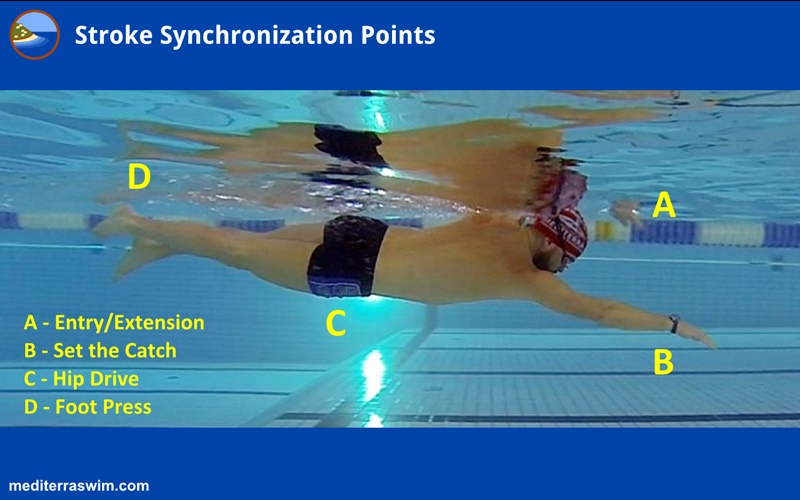Forums › Library › Knowledge Base › Synchronized Propulsion Combinations
Please type your comments directly in the reply box - DO NOT copy/paste text from somewhere else into the reply boxes - this will also copy the code behind your copied text and publish that with your reply, making it impossible to read. Our apology for the inconvenience, but we don't see a convenient way of fixing this yet.
Tagged: 2 beat kick, hip drive, knowledge base, propulsion, spear, synchronization, the catch
-
AuthorPosts
-
August 20, 2014 at 17:30 #3259
Admin Mediterra
KeymasterYou’ve worked on building each section of the stroke, each part of the body, piece by piece. They are intended to work together as a harmonious whole. So, eventually, you need to practice connecting these parts and then tuning them to create smooth and powerful propulsive movements.
When these parts of the stroke are not connected, or not connected well, it causes what we call ‘power leaks’ in your propulsion. You may be harvesting free force from gravity, you may be generating momentum with the recovery swing and the torso rotation, you may be anchoring your catch hand, but if all these parts are not connected and timed well, a great portion of the power from one part of the body cannot be transferred to another where it would be used. When these parts are connected and timed well, they do not merely add up, the magnify the power you are able to apply to each stroke.
Synchronization practice will help tie each piece of the movement together, and plug those power leaks.
How To Work With Combinations
You start with paying attention to the connection of two synchronization points at a time (like AB, or BC), examining and refining them. After working with related pairs for a while, you may ‘zoom out’ to hold attention on hold three points at a time (like ABC), feeling how they all work together. In the end, you intend to have all four working in smooth synchronicity, but it will be easier to arrive at that when you work on these in pairs, rotating through the combinations.
Eventually, all the individual pieces are brought together here in the full stroke to create a smooth, powerful, synchronized, whole-body propulsive movement.

Description Of Sync Combinations
AB – the moment the entry hand (A) pierces the water is the moment your lead arm (B) sets the catch. If that entry happens a little too late or a little too early, then you are not able to connect the rotation power to the catch.
AC – the entry and extension arm (A) is entering and pulling the hip (C) after it, as if the hip is pulled by an elastic band.
CA – the extending arm (A) underwater feels as if it is being pushed forward by the rotation of the hip. It is another way of viewing the same connection as AC.
BC – the catch arm slides into catch shape (B) but then hesitates for a microsecond as the hip (C) begins to rotate, then the catch arm can gradually increase pressure and shift the loading to the back muscles, lightening the load a bit on the smaller shoulder muscles. Imagine an elastic band tied from the hip to the wrist, and as the hip turns it pulls the catch arm with it.
DC – the press of the foot (D) in a downward arc helps rotate the same side hip (C) upward.
DB – being connected through the hip (torso), the press of the foot also assists with the catch – the press of the foot downward (by helping the hip rotate upward) lightens the loading on the catch arm slightly.
DA – being connected through the torso, the press of the foot (D) on one side of the body helps the entering arm (A) extend fully into Skate Position on the other side of the body.
Example Practice Set 1
4 Rounds of 3x (2x 25m), one for each combination of points.
Rotate through the Synchronization Combo Points:
- Round #1 – AB, AC, AD
- Round #2 – BA, BC, BD
- Round #3 – CA, CB, CD
- Round #4 – DA, DB, DC
You may pick specific Focal Points to use for each stroke section:
- A = Mailslot, Entry, Extension Focal Points
- B = Catch Focal Points
- C = Hip Drive, Rotation Focal Points
- D = 2-Beat Kick Focal Points
You may refer to the list of focal points (in your original lesson notes) for each of these individual sections of the stroke. Then you may look at the 101 Focal Points page for additional focal points.
Example Practice Set 2
3 rounds of 3x 150 whole stroke.
Using a Tempo Trainer at a comfortable cruising tempo is optional.
- Round #1 – focus on AC
- Round #2 – focus on BC
- Round #3 – focus on ABC
-
AuthorPosts
- You must be logged in to reply to this topic.
